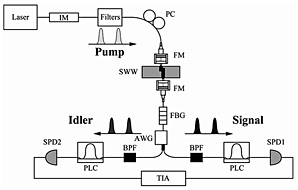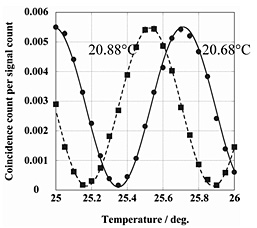Toshifumi Watanabe*, Koji Yamada*, Yasuhiro Tokura, and Sei-ichi Itabashi*
Optical Science Laboratory, *Microsystem Integration Laboratories
Recently, 1.5-µm band entangled photon pair generation using spontaneous
four-wave mixing (SFWM) in a silicon wire waveguide (SWW) has been drawing
attention [1]. An SWW is expected to function as a high-purity entangled
photon pair generation device. By using an SWW, we obtained two-photon
interference fringes of time-bin entangled photons with > 95% visibilities
[2].
An SWW is a nano-scale silicon waveguide fabricated on silicon-on-insulator
wafer [3]. An SWW exhibits very large third order nonlinearity because
of its extremely small effective area, and thus we can obtain efficient
SFWM in a waveguide whose length is 〜1 cm.
Figure 1 shows experimental setup. The laser light is modulated into double
pulses with a repetition frequency of 100 MHz by using an intensity modulator
(IM). The pulse width and interval are 90 ps and 1 ns, respectively. The
double pulses are input into an SWW. The SWW used in the experiment is
460 nm wide, 200 nm thick, and 1.15 cm long. The excess loss of the SWW
is 1.0 dB. Consequently, time-bin entangled photon pairs are generated
through the SFWM in the SWW. The photons from the SWW are launched into
a fiber Bragg grating (FBG) to suppress the pump photons, and input into
an arrayed waveguide grating (AWG) to separate the signal and idler photons.
The signal and idler wavelengths are ± 3.2 nm from the pump wavelength.
Each photon is then launched into a 1-bit delayed interferometer fabricated
using planar lightwave circuits (PLC) based on silica waveguide technology.
The phase difference between two paths of the interferometer is precisely
controlled by adjusting the temperature of the substrate. The photons from
the PLC interferometers are received by single photon detectors (SPD) operated
in a gate mode whose gate frequency is 100 MHz.
We fixed the signal interferometer temperature and counted the coincidences
while changing the idler interferometer temperature (fig. 2). The solid
and dashed lines represent the measurement results obtained with nonorthogonal
measurement bases for the signal photons. The visibilities of fitted curves
are 96.3% (solid) and 95.2% (dashed). Thus, we successfully confirmed the
generation of a high-purity entangled state in the 1.5-µm band.
[1] H. Takesue et al., Appl. Phys. Lett. 91 (2007) 201108.
[2] K. Harada et al., Opt. Express 16 (2008) 20368.
[3] T. Tsuchizawa et al., IEEE J. Sel. Top. Quantum Electron. 11 (2005) 232.
 |
 |
|||||
|
|